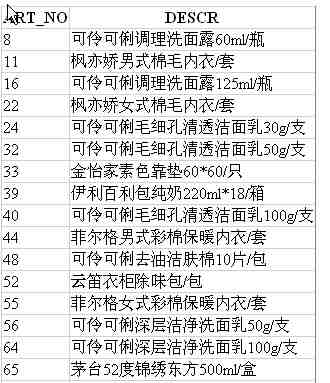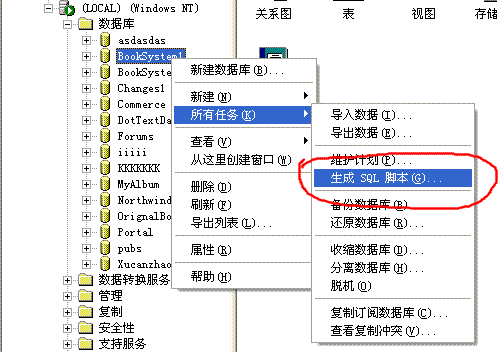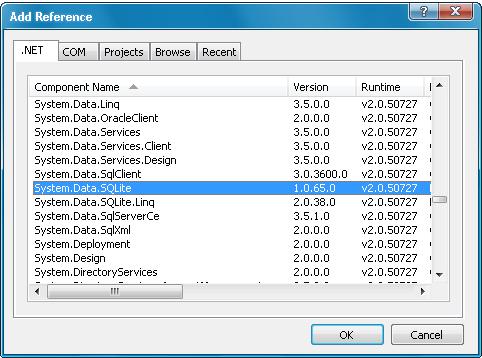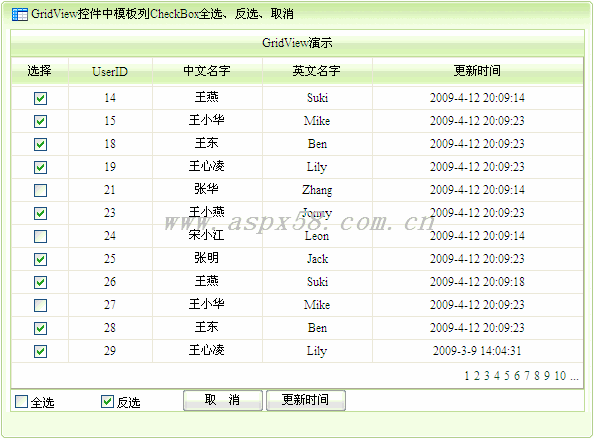|
|
SqlConnection nwindConn = new SqlConnection("Data Source=localhost;Integrated Security=SSPI;Initial Catalog=northwind");
SqlCommand selectCMD = new SqlCommand("SELECT CustomerID, CompanyName FROM Customers", nwindConn);
selectCMD.CommandTimeout = 30;
SqlDataAdapter custDA = new SqlDataAdapter();
custDA.SelectCommand = selectCMD;//通過SqlCommand給SqlDataAdapter設定參數,也可//直接用select語句
nwindConn.Open();
DataSet custDS = new DataSet();
custDA.Fill(custDS, "Customers");
nwindConn.Close();
多個結果集
如果 DataAdapter 遇到多個結果集,它將在 DataSet 中創建多個表。將向這些表提供遞增的默認名稱 TableN,以表示 Table0 的“Table”為第一個表名。如果以參數形式向 Fill 方法傳遞表名稱,則將向這些表提供遞增的默認名稱 TableNameN,這些表名稱以表示 TableName0 的“TableName”為起始。
從多個 DataAdapter 填充 DataSet
可以將任意數量的 DataAdapter 與一個 DataSet 一起使用。每個 DataAdapter 都可用于填充一個或多個 DataTable 對象并將更新解析回相關數據源。DataRelation 和 Constraint 對象可以在本地添加到 DataSet,這樣,您就可以使來自多個不同數據源的數據相關聯。例如,DataSet 可以包含來自 Microsoft SQL Server 數據庫、通過 OLE DB 公開的 IBM DB2 數據庫以及對 XML 進行流處理的數據源的數據。一個或多個 DataAdapter 對象可以處理與每個數據源的通信。
以下代碼示例從 Microsoft SQL Server 2000 上的 Northwind 數據庫填充客戶列表,從存儲在 Microsoft? Access 2000 中的 Northwind 數據庫填充訂單列表。已填充的表通過 DataRelation 相關聯,然后客戶列表將與相應客戶的訂單一起顯示出來。有關 DataRelation 對象的更多信息,請參見添加表間關系和導航表間關系。
SqlConnection custConn = new SqlConnection("Data Source=localhost;Integrated Security=SSPI;Initial Catalog=northwind;");
SqlDataAdapter custDA = new SqlDataAdapter("SELECT * FROM Customers", custConn);
OleDbConnection orderConn = new OleDbConnection("Provider=Microsoft.Jet.OLEDB.4.0;" + "Data Source=c:\\Program Files\\Microsoft Office\\Office\\Samples\\northwind.mdb;");
OleDbDataAdapter orderDA = new OleDbDataAdapter("SELECT * FROM Orders", orderConn);
custConn.Open();
orderConn.Open();
DataSet custDS = new DataSet();
custDA.Fill(custDS, "Customers");
orderDA.Fill(custDS, "Orders");
custConn.Close();
orderConn.Close();
DataRelation custOrderRel =
custDS.Relations.Add("CustOrders",custDS.Tables["Customers"].Columns["CustomerID"], custDS.Tables["Orders"].Columns["CustomerID"]);
foreach (DataRow pRow in custDS.Tables["Customers"].Rows)
{
Console.WriteLine(pRow["CustomerID"]);
foreach (DataRow cRow in pRow.GetChildRows(custOrderRel))
Console.WriteLine("\t" + cRow["OrderID"]);
}
SQL Server Decimal 類型
DataSet 使用 .NET Framework 數據類型來存儲數據。對于大多數應用程序,這些類型都提供了一種方便的數據源信息表示形式。但是,當數據源中的數據類型是 SQL Server decimal 時,這種表示形式可能會導致問題。.NET Framework decimal 數據類型最多允許 28 個有效位,而 SQL Server decimal 數據類型則允許 38 個有效位。如果 SqlDataAdapter 在 Fill 操作過程中確定 SQL Server decimal 字段的精度大于 28 個字符,則當前行將不會被添加到 DataTable 中。此時將發生 FillError 事件,它使您能夠確定是否將發生精度損失并作出適當的響應。有關 FillError 事件的更多信息,請參見使用 DataAdapter 事件。若要獲取 SQL Server decimal 值,還可以使用 SqlDataReader 對象并調用 GetSqlDecimal 方法。
在 Update 過程中使用 SqlCommand,更改DataSet記錄
以下示例使用派生類 OleDbDataAdapter 來對數據源進行 Update。此示例假定您已經創建了一個 OleDbDataAdapter 和一個 DataSet。
以下示例使用派生類 OleDbDataAdapter 來對數據源進行 Update。此示例假定您已經創建了一個 OleDbDataAdapter 和一個 DataSet。
public DataSet CreateCmdsAndUpdate(DataSet myDataSet,string myConnection,string mySelectQuery,string myTableName)
{
OleDbConnection myConn = new OleDbConnection(myConnection);
OleDbDataAdapter myDataAdapter = new OleDbDataAdapter();
myDataAdapter.SelectCommand = new OleDbCommand(mySelectQuery, myConn);
OleDbCommandBuilder custCB = new OleDbCommandBuilder(myDataAdapter);
myConn.Open();
DataSet custDS = new DataSet();
myDataAdapter.Fill(custDS);
//code to modify data in dataset here
myDataAdapter.Update(custDS, myTableName);
myConn.Close();
return custDS;
}
下面的實例將創建一個 SqlDataAdapter 并設置 SelectCommand 和 InsertCommand 屬性。假定已經創建一個 SqlConnection 對象。
public static SqlDataAdapter CreateCustomerAdapter(SqlConnection conn)
{
SqlDataAdapter da = new SqlDataAdapter();
SqlCommand cmd;
// Create the SelectCommand.
cmd = new SqlCommand("SELECT * FROM Customers " +
"WHERE Country = @Country AND City = @City", conn);
cmd.Parameters.Add("@Country", SqlDbType.NVarChar, 15);
cmd.Parameters.Add("@City", SqlDbType.NVarChar, 15);
da.SelectCommand = cmd;
// Create the InsertCommand.
cmd = new SqlCommand("INSERT INTO Customers (CustomerID, CompanyName) " +
"VALUES (@CustomerID, @CompanyName)", conn);
cmd.Parameters.Add("@CustomerID", SqlDbType.NChar, 5, "CustomerID");
cmd.Parameters.Add("@CompanyName", SqlDbType.NVarChar, 40, "CompanyName");
da.InsertCommand = cmd;
return da;
}
下面的實例創建一個 SqlDataAdapter 并設置 SelectCommand 和 DeleteCommand 屬性。假定已經創建一個 SqlConnection 對象。
public static SqlDataAdapter CreateCustomerAdapter(SqlConnection conn)
{
SqlDataAdapter da = new SqlDataAdapter();
SqlCommand cmd;
SqlParameter parm;
// Create the SelectCommand.
cmd = new SqlCommand("SELECT * FROM Customers " +
"WHERE Country = @Country AND City = @City", conn);
cmd.Parameters.Add("@Country", SqlDbType.NVarChar, 15);
cmd.Parameters.Add("@City", SqlDbType.NVarChar, 15);
da.SelectCommand = cmd;
// Create the DeleteCommand.
cmd = new SqlCommand("DELETE FROM Customers WHERE CustomerID = @CustomerID", conn);
parm = cmd.Parameters.Add("@CustomerID", SqlDbType.NChar, 5, "CustomerID");
parm.SourceVersion = DataRowVersion.Original;
da.DeleteCommand = cmd;
return da;
}
下面的實例將創建一個 SqlDataAdapter 并設置 SelectCommand 和 UpdateCommand 屬性。假定已經創建一個 SqlConnection 對象。
public static SqlDataAdapter CreateCustomerAdapter(SqlConnection conn)
{
SqlDataAdapter da = new SqlDataAdapter();
SqlCommand cmd;
SqlParameter parm;
// Create the SelectCommand.
cmd = new SqlCommand("SELECT * FROM Customers " +
"WHERE Country = @Country AND City = @City", conn);
cmd.Parameters.Add("@Country", SqlDbType.NVarChar, 15);
cmd.Parameters.Add("@City", SqlDbType.NVarChar, 15);
da.SelectCommand = cmd;
// Create the UpdateCommand.
cmd = new SqlCommand("UPDATE Customers SET CustomerID = @CustomerID, CompanyName = @CompanyName " +
"WHERE CustomerID = @oldCustomerID", conn);
cmd.Parameters.Add("@CustomerID", SqlDbType.NChar, 5, "CustomerID");
cmd.Parameters.Add("@CompanyName", SqlDbType.NVarChar, 40, "CompanyName");
parm = cmd.Parameters.Add("@oldCustomerID", SqlDbType.NChar, 5, "CustomerID");
parm.SourceVersion = DataRowVersion.Original;
da.UpdateCommand = cmd;
return da;
}
AspNet技術:asp.net SqlDataAdapter對象使用札記,轉載需保留來源!
鄭重聲明:本文版權歸原作者所有,轉載文章僅為傳播更多信息之目的,如作者信息標記有誤,請第一時間聯系我們修改或刪除,多謝。



